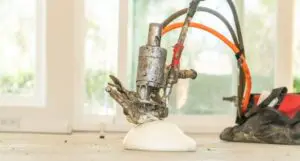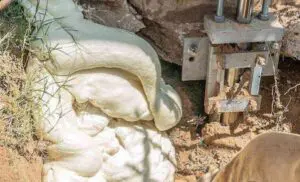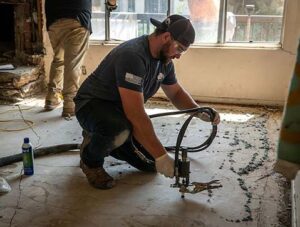When you hear deep injection, foundation repair isn’t something you associate with that term, especially when it comes to having that Thanksgiving turkey ready for the holidays. Instead, an environmentally safe substance is injected into the ground to help lift and stabilize your home or business.
Deep injection with polyurethane foam is used in wonderful ways when it comes to foundation repair, capable of lifting a building a little bit (under the right circumstances) up to filling the voids and micro voids in the ground. But how deep does deep injection go? Literally? How deep into the ground does it go?
Dalinghaus Construction has over 100 years of combined experience in foundation repair, having done over 2,000 projects since 2015. We’ve done our fair share of projects involving deep injection with polyurethane foam. And we’ll do more in the future.
Let’s get you started on deep injection. And then we’ll explore deeper. Pun intended.
What is deep injection?
This is done to densify soil by filling voids and microvoids at different layers. It’s a piece of cake to bake a pretty cake, but you still want to be sure your layers are perfect without a major gap.

Deep injection with polyurethane is usually done after lifting a slab-on-grade home to ensure the soil stabilizes your entire foundation.
Dalinghaus Construction uses polyurethane foam for deep injection since it’s significantly lighter and significantly messy compared to other methods like mud jacking.
Polyurethane foam for deep injections is like getting all of your paint on the canvas to make a beautiful piece of art, whereas mud jacking is getting some paint on the canvas while the rest is on the walls, floors, ceiling, dog, wife, etc.
Polyurethane foam is significantly less messy compared to its concrete counterpart.
What is polyurethane?
Polyurethane foam is water-resistant, non-invasive, and environmentally safe. It’s an injectable polyol and isocyanate resin that rapidly expands when fused to create a foam that can be as hard as concrete.

It really needs to be emphasized how safe it is. Polyurethane is used for pacemakers, which are implanted in your body. Think of a category. You can probably find out how polyurethane fits in it.
Mud jacking uses concrete, which takes weeks to properly cure and can weigh 140 pounds per cubic foot. Polyurethane foam cures in 15 minutes, weighing 3-5 pounds per cubic foot
Learn about the history of polyurethane and when it’s used for foundation repair.
When is polyurethane used?
We’ll rapidly expand on how polyurethane foam is applied.
Void fill
Void fill is what it is. It’s filling voids. If you lift a home or business, there will be voids left over.
Deep injection isn’t considered void fill, even though it does fill voids. It isn’t the primary focus. It’s part of the result.
Polyurethane foam fills voids, fissures, and micro voids. The process is soil densification. You’ll usually see voids being filled alongside galvanized push pier or helical pier underpinnings after lifting your home or business.
The last thing you want under your home or business is soil with the strength of a twig.
Releveling
When we say releveling, it means polyurethane is doing its part in lifting a building. Crazy, right?
But don’t think polyurethane foam injection will do the job of lifting a home 16 inches. The lift is small. A home or business can be lifted an inch or two under good conditions.
You can also have deep and shallow injections depending on if you’re trying to lift. Smaller tubes might be injected into the soil if you can only lift the slab. Longer tubes will lift the soil and the slab. So the soil is being stabilized while getting lifted at the same time.
Structural support
When you lift your home, you can expect structural support to go with void fill like salt and pepper on a medium-rare steak. That said, galvanized steel underpinnings aren’t necessary for structural support.
Structural support with polyurethane foam depends on if the soil is highly expansive. Your soil is constantly expanding and shrinking when polyurethane isn’t. When polyurethane expands, you won’t see any contraction later.
When you have grainier or sandy soil, you have fewer problems with polyurethane. They go well together like a good chili and a baked potato.
How deep do you do deep injection with polyurethane?
The depth for a deep injection tube is as deep as required. I know. That doesn’t really answer your question.
It will typically be 3 to 7 feet since the footing is (usually) 12-24 inches deep. You need to make sure those tubes are under the slab. The polyurethane foam will expand rapidly like a sphere. You can think of polyurethane foam expanding at a 2.5 feet radius. It’s not a perfect sphere by any means, but it (hopefully) gives you a good idea of the rapid expansion.
How is depth determined?
The way it’s done is by using a Dynamic Cone Penetrometer (DCP). These measure soil depth and density by measuring the penetration into the soil after each blow.
Moisture can affect the depth
Excessive moisture or saturated soil uses more material since the soil is looser. The type of polyurethane foam might also affect depth depending on if it’s hydrophobic or not.
Different types of polyurethane can be used such as single or double components. Single is activated by moisture, whereas the dual component is hydrophobic, causing it to disperse moisture.
So some types of polyurethane are used that will determine how deep the injection goes. There are so many compared to back in the day. It’s all dependent on chemistry.
Some are slow-reacting, others react with moisture in their own unique way, and some have a very quick reaction time.
They all fit the same purpose in permeating and densifying soil.
Cost of deep injection
Deep injection with polyurethane pricing depends on soil conditions and what’s suitable for your repair. Dalinghaus Construction charges $110 per square foot.
You can also look at how much polyurethane costs, whether it’s for void fill, soil stabilization, releveling, or deep injection.
Don’t think too deeply. Have Dalinghaus Construction help with your deep injection needs.

You’ve learned about what deep injection is, polyurethane, how deep injection with polyurethane is applied, the depth needed for polyurethane deep injection, and the cost of deep injection. Take a deep dive to learn more about deep injection, polyurethane, and other applications for foundation repair.
You can also schedule a FREE foundation inspection with us to see if we’re the perfect fit for your deep injection needs.
How is polyurethane foam injection done? There are 5 steps you can learn from drilling holes to the curing process.
If you’re concerned about polyurethane being dangerous, don’t be. That said, don’t be afraid to learn more about how polyurethane foam is environmentally safe.
For additional questions or to schedule an evaluation, call Dalinghaus Construction at (877)360-9277.





